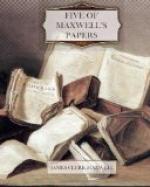It is very necessary that those who are trying to learn from books the facts of physical science should be enabled by the help of a few illustrative experiments to recognise these facts when they meet with them out of doors. Science appears to us with a very different aspect after we have found out that it is not in lecture rooms only, and by means of the electric light projected on a screen, that we may witness physical phenomena, but that we may find illustrations of the highest doctrines of science in games and gymnastics, in travelling by land and by water, in storms of the air and of the sea, and wherever there is matter in motion.
This habit of recognising principles amid the endless variety of their action can never degrade our sense of the sublimity of nature, or mar our enjoyment of its beauty. On the contrary, it tends to rescue our scientific ideas from that vague condition in which we too often leave them, buried among the other products of a lazy credulity, and to raise them into their proper position among the doctrines in which our faith is so assured, that we are ready at all times to act on them.
Experiments of illustration may be of very different kinds. Some may be adaptations of the commonest operations of ordinary life, others may be carefully arranged exhibitions of some phenomenon which occurs only under peculiar conditions. They all, however, agree in this, that their aim is to present some phenomenon to the senses of the student in such a way that he may associate with it the appropriate scientific idea. When he has grasped this idea, the experiment which illustrates it has served its purpose.
In an experiment of research, on the other hand, this is not the principal aim. It is true that an experiment, in which the principal aim is to see what happens under certain conditions, may be regarded as an experiment of research by those who are not yet familiar with the result, but in experimental researches, strictly so called, the ultimate object is to measure something which we have already seen—to obtain a numerical estimate of some magnitude.
Experiments of this class—those in which measurement of some kind is involved, are the proper work of a Physical Laboratory. In every experiment we have first to make our senses familiar with the phenomenon, but we must not stop here, we must find out which of its features are capable of measurement, and what measurements are required in order to make a complete specification of the phenomenon. We must then make these measurements, and deduce from them the result which we require to find.
This characteristic of modern experiments—that they consist principally of measurements,—is so prominent, that the opinion seems to have got abroad, that in a few years all the great physical constants will have been approximately estimated, and that the only occupation which will then be left to men of science will be to carry on these measurements to another place of decimals.




